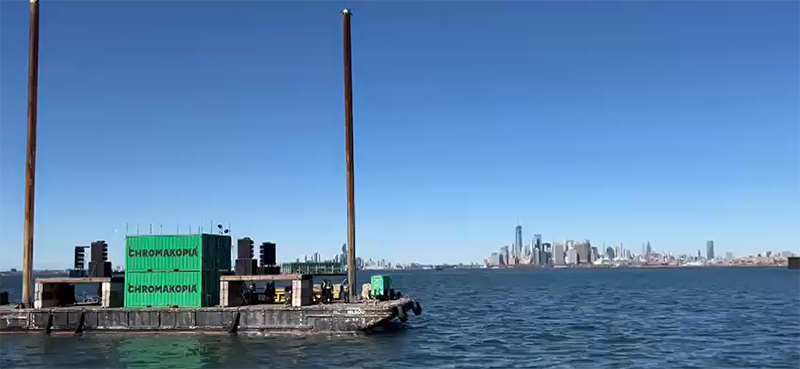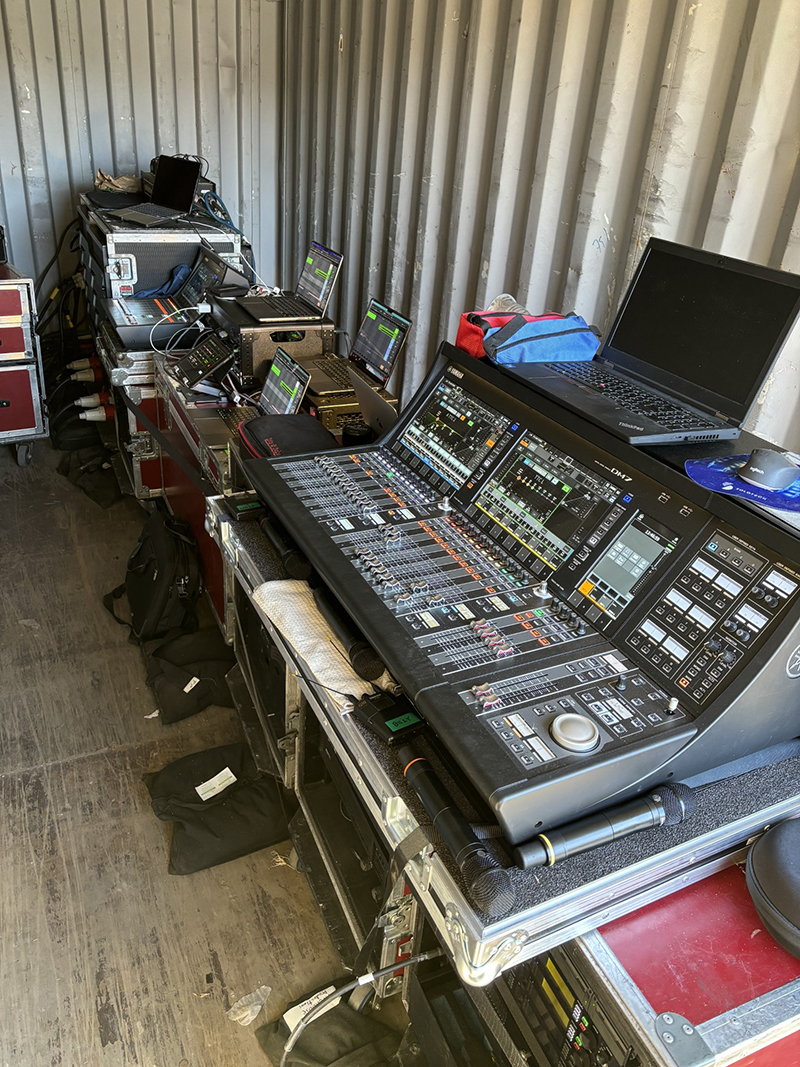Mixing Tyler, The Creator’s Barge Pop-up Show in Brooklyn
April 16, 2025
This article was sourced from FOH Online.
BROOKLYN, NY – Tyler, the Creator, now out on his green shipping container-themed Chromakopia tour in support of his Oct. 2024 album release by the same name, has been using similar-looking containers as a stage for a series of pop-up events. For one such event on Brooklyn’s waterfront, the stage made from shipping containers appeared on a floating barge. Yamaha detailed how engineers Paul Wichmann (FOH) and Landon Storey (MON) used a DM7C / DM7 console setup to mix the music for fans gathered on the Brooklyn pier.

Landon Storey and Paul Wichmann’s engineering expertise transforms Tyler, The Creator’s concerts into unforgettable experiences. From innovative pop-up shows on barges to arena-sized performances, their seamless collaboration tackles unique audio setups, delivering spectacular musical experiences worldwide.
In the world of live music, delivering an unforgettable performance requires more than just talent on stage – it demands seamless collaboration behind the scenes. Enter Landon Storey (MON) and Paul Wichmann (FOH), the dynamic engineer team responsible for ensuring Tyler, The Creator’s concerts are nothing short of spectacular. From innovative pop-up shows to arena-sized performances, their expertise and partnership have tackled some of the most unique and challenging audio setups, bringing amazing musical experiences from the waters of New York City to the grand stages of international arenas.
One of the most unique and challenging experiences in Landon and Paul’s careers was the barge pop-up show with Tyler, The Creator. The show took place on a barge that traveled across the Narrows, the channel between Staten Island and Brooklyn where the Hudson River empties into the Atlantic Ocean, with fans watching from the pier.
Given the constraints of the barge, Landon and Paul chose Yamaha DM7C and the DM7, capitalizing on the mid-sized footprint, power and robust feature sets. “The DM7’s workflow is so similar to the Rivage PM series, which made the transition seamless,” Landon notes, referring to his go-to Rivage PM5 desk. “We were able to quickly get up to speed and deliver the same high-quality audio experience.”

“We showed up and they just shoved those poles down in the mud and we do a show,” Landon explains. The setup involved four storage containers stacked on the barge, creating a makeshift stage and control room. Paul elaborates, “The PA was actually floated on the barge as well. The performance space was double stack shipping containers on the barge for him as a stage. And then outside of that, they had built some kind of platform for the speakers. All the control, monitor world, playback, and my front of house was inside one of the shipping containers.”
Landon and Paul faced several challenges, including limited space for mounting antennas and crowd mics, and the vibrations from the metal containers affecting the audio quality. “Being in a big metal container and then mixing inside of a container that’s basically got the equivalent of a trunk rattle from when you’re in high school,” Landon says.
Paul adds “the big challenge was it is just storage containers with handrails leaving very little to mount the antennas to, there’s nothing to mount crowd mics to, and if there’s a problem, how do you get up there?”
Despite these obstacles, the team successfully set up the entire audio system on a 12-foot folding table, showcasing the compact yet powerful capabilities of the DM7 consoles. “It was pretty impressive that you could fit Paul’s DM7 compact, my full-size DM7, and then the playback guy in the middle with a couple of Dante switches and an analog whip feeding an analog split,” Landon notes. The use of battery-powered generators eliminated the usual noise issues, allowing for a quieter and more immersive experience.
“There was no generator noise. It was just these huge generators, but they were just battery packs, so it was quiet,” Landon explains. He mixed monitors from inside the storage container, relying on his technical skills and the features of the DM7 to deliver a high-quality performance.
Paul shares his FOH experience mixing the show remotely: “I literally had the DM7 in a shipping container on the barge, and then I ran a router outside of it and just mixed it with an iPad. When the barge got close enough, I connected my iPad, and then I mixed the show off an iPad (via Yamaha’s StageMix app), which was really slick.” The audience’s reaction was electric. “The fans were on the pier, and they were just going wild. It was a once-in-a-lifetime experience for them,” Paul recalls. “Tyler’s fans are incredibly dedicated, and they loved the unique setup.”
Managing Tyler’s Dynamic Performance
One of the biggest challenges Landon faced was managing Tyler’s dynamic vocal performance. “He’s very dynamic. To go from talking as loud as you and I are to literally almost distorting a mic capsule, it was interesting to try to dial that in,” Landon explains. He used the 1176 compressor and dynamic EQ plug-ins to manage Tyler’s vocal range effectively. Paul adds, “The Neve 5045 Primary Source Enhancer is critical for my job. He goes in front of the PA all the time. The dynamic EQ works well on the DM7C too, it’s solid.”
Landon also highlighted the importance of having the same in-ear monitor model as Tyler to ensure he was hearing the same thing Tyler was. “If you don’t have the same, if you’re not hearing the same thing, you’re trying to imagine what it would sound like or what they’re saying it sounds like, but that’s not always good information coming back to you,” he explains.

From the Hudson River Back to the Road
After they got off the water, Landon and Paul hit the road with Tyler, The Creator to packed-house arena-sized venues behind their respective MON (Rivage PM5) and FOH (analog Gamble console with a DM7 for backup), but the DM7’s left an indelible memory. “The DM7 has all the Neve stuff in it. It has a distortion plug-in that I think sounds really, really good,” Paul says. Landon’s experience with effects-heavy concerts, such as his work with Khalid, also played a crucial role.
“I got an opportunity to do a pop tour with this young kid named Khalid, and it was just a rocket ship. It quickly grew to arenas and exploded,” Landon recalls. This background prepared him well for the dynamic and heavy processing nature of Tyler’s shows, and the DM7 and Rivage PM desks were up to the task to bring Tyler’s dynamic performance to the audience.
Landon and Paul both have specific techniques and preferences when it comes to mixing Tyler, The Creator. Landon explains, “Listening to his albums, he’s very effects heavy. He’s got a lot of vocal doubling, harmonizers, and distortion effects. And I had heard that he’s not shy from hearing that in his own ears.” Paul shares his approach to maintaining a clean signal path: “I don’t go crazy with plugins. I like some of the tools, but I really try not to overuse them. I try to keep stuff real minimal. All my compression is pretty minimal. Any of the dynamic EQ stuff, I’m not living in it.”
Summary
From innovative barge shows to arena-sized performances, Landon Storey and Paul Wichmann’s expertise and partnership have transformed Tyler, The Creator’s concerts into unforgettable, once-in-a-lifetime experiences. Their adventurous spirit and technical prowess have pushed the boundaries of live music, delivering compelling soundscapes that captivate audiences worldwide. From the waters of New York City to the grand stages of international arenas, their work continues to set new standards in live audio production.